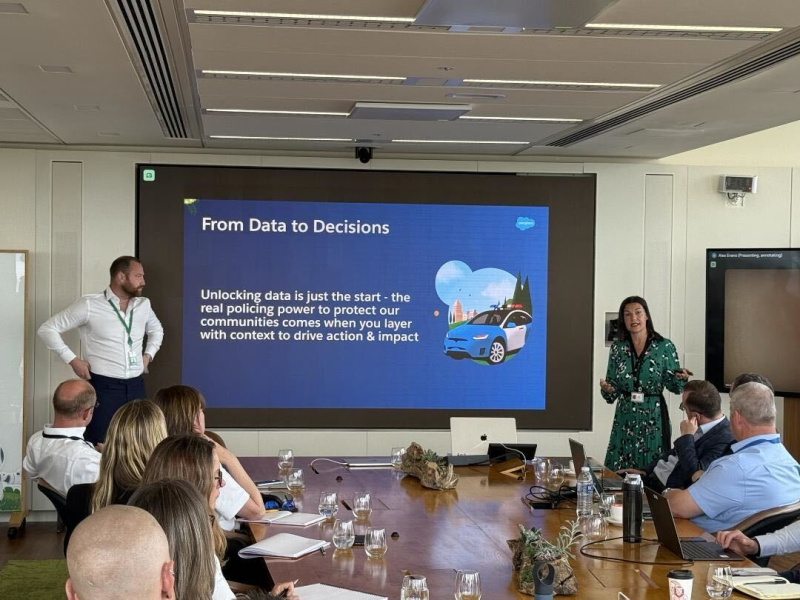Just over twelve months ago, I spoke at a national contact management event. WIth just 8 minutes to address the critical challenges facing policing at the first point of contact, I spent four of these dedicated to outlining a stark picture of the pressures on police control rooms – the unrelenting demand, the often-outdated and siloed systems and the tireless dedication of the professionals striving to deliver public safety against mounting odds. The other four minutes were focused on something more optimistic: the immense opportunities that lay ahead for transformation.
The control room is undeniably the nerve centre of any police force. It’s where the public’s calls for help are first heard, where critical decisions are made and where the initial threads of an incident response are woven
As I travelled home afterwards, I decided it wasn’t enough to simply articulate the problems and potential; I felt compelled to be part of the solution, to stand behind my words and actively contribute to national improvement. This conviction led me to join the policing team at Salesforce and for the past year it has allowed me to work with colleagues directly on alleviating the very challenges I spoke of.
For over two decades, I have worked and led within police control rooms and my purpose has remained unchanged – to help drive positive, lasting change for policing and the public. This past year, that purpose has found new momentum through our partnership with police forces across the country to support innovation that’s grounded in real-world impact.
The control room is undeniably the nerve centre of any police force. It’s where the public’s calls for help are first heard, where critical decisions are made and where the initial threads of an incident response are woven. This isn’t about technology for its own sake. It’s about what it enables – improved outcomes for victims, stronger public confidence and more effective support for those on the front line. While there’s still much to do, our team’s direction is clear and it’s shaped by a shared, unwavering commitment to doing the right thing.
Yet, for too long police forces have grappled with a multitude of interconnected issues that deeply impact service delivery and public trust:
- Overwhelming Demand: The police service faces overwhelming demand, an increase in complexity and taking on issues other organisations could not manage. Police control rooms are consistently on the front line of societal challenges, handling high volumes of calls, many of which are not emergencies but require significant time and resources. HMICFRS reports have repeatedly highlighted the danger of control rooms being overwhelmed by rising and complex demand.
- Legacy Systems and Data Silos: Many forces still operate with disparate, often outdated systems that hinder a holistic view of an individual or incident. This fragmentation leads to inconsistencies in how forces manage demand, assess risk and share critical information, potentially impacting vulnerable people who need swift and coordinated support. Teams frequently report having to ‘double key’ contact demand and type the same information into different systems, as well as needing to check various systems for different information, a process which is not only time-consuming but also a source of significant frustration.
- Inconsistent Public Experience: A lack of standardised practices and response times across forces leaves the service to the public uneven and under strain. The quality of service the public receives can unfortunately be dependent on where they live, a direct consequence of inconsistent approaches to contact management and varying technological capabilities across forces.
- Resource Strain: The nature of the call handler role has shifted, leading to a reduction in the average tenure. This means that while dedicated professionals continue to staff control rooms, there’s a growing need to address the experience gap that can arise with a more rapidly evolving workforce. Overtime has become standard practice and relied upon, often carried out by the same group of people contributing to burnout and staffing issues. Smaller budgets and fewer personnel exacerbate the challenges, making it difficult to recruit, retain and adequately train the highly skilled professionals needed to manage the complexity of control room operations.
These challenges are not just operational hurdles; they directly impact public trust and confidence in policing. When calls go unanswered, or information isn’t readily available, it erodes the very foundation of policing by consent. High levels of ‘failure demand’ lead to long wait times, high abandonment rates, inconsistent responses and reduced call resolution.
Turning Challenge into Opportunity: The Salesforce Approach
 Over the past five years, Salesforce has been instrumental in supporting national efforts to modernise policing, specifically in enhancing citizen engagement and service delivery.
Over the past five years, Salesforce has been instrumental in supporting national efforts to modernise policing, specifically in enhancing citizen engagement and service delivery.
Technology, when strategically applied, can be a powerful catalyst for positive change and the Salesforce platform has a robust and proven track record, evidencing positive results in multiple police forces across the UK.
Our work focuses on providing a flexible, scalable and secure platform that empowers forces to:
- Gain a Single View of the Citizen and Enhance the Victim Journey with Personalised Communication: This is paramount. By consolidating touchpoints and integrating with existing legacy systems, Salesforce CRM enables forces to bring all information related to a citizen into a single, comprehensive view shifting from location-centricity to Citizen 360. This means call handlers and officers can quickly identify vulnerable individuals, access historical interactions and make more informed decisions, leading to a truly personalised and empathetic response. Salesforce Victim Journey provides this personalised communication. Humberside Police, for example, transformed their victim journey, reducing phone enquiries and boosting public trust by proactively updating citizens through automated communications tailored to crime type, demographics and risk levels. A key theme identified from police teams is the need to better support victims and keep them updated, with the majority of complaints currently about not receiving updates. Salesforce enables proactive victim engagement through automated, timely and relevant communications, including instant reference numbers, easy portal access, real-time case updates, victim support info, crime prevention guidance, CSI advice and compensation advice.
- Automate and Streamline Processes: Many routine administrative tasks within control rooms can be automated, freeing up valuable officer and staff time to focus on complex incidents and critical decision-making. This includes automating communication updates, case tracking and leveraging AI for initial triage of non-emergency contacts. The aim is not to replace human interaction but to augment it, ensuring the right resources are deployed where they are needed most.This also helps increase call handler productivity by reducing double keying, ‘swivel chair’ processes and manual tasks.
- Enhance Interoperability and Data Exchange: Our platform facilitates the easy and secure exchange of data between different police force systems and external agencies. This seamless flow of information ensures that everyone involved in an incident has access to the right intelligence at the right time, improving coordination and effectiveness. The North West Regional Organised Crime Unit (NWROCU) uses Salesforce technology to collaborate across six police forces and multiple agencies without requiring system standardisation, demonstrating effective regional intelligence sharing.
- Empower Self-Service and Digital Engagement: The public increasingly expects convenient digital options for interacting with police forces. By implementing intuitive self-service portals, forces can empower citizens to report crimes, track cases, and access vital information online. The Salesforce Citizen Portal, for example, facilitates two-way communication between the public and their assigned officer, significantly reducing the burden on traditional phone lines and improving overall accessibility. A compelling example of this success can be seen with Thames Valley Police and Hampshire & Isle of Wight Constabulary. After implementing the Salesforce Victim Journey and Citizen Portal, they achieved a reduction of 163,500 calls on 101 over 88 weeks. This equates to the capacity of 31 full-time equivalent (FTE) staff and a substantial £1.4 million in cashable savings, freeing up critical resources for emergency calls.

Benefits to Policing and Partnership in Action
The benefits of this technological shift, driven by strong partnerships between Salesforce and police forces, are significant and far-reaching, directly addressing the national vision for contact management:
- Improved Victim Journey and Adherence to Victims’ Code of Practice (VCOP): Beyond just efficiency, personalised communication is revolutionising the victim experience. Salesforce’s platform directly supports forces in adhering to the 12 codes of VCOP by providing automated, timely and relevant updates throughout the entire crime journey, from initial report through investigation, charge and court stages. Forces are seeing a significant increase in citizen satisfaction, particularly for serious crimes (15-60% reported in forces utilising this approach). This consistent, empathetic engagement helps victims feel more informed and supported throughout the judicial process, directly addressing concerns about not receiving updates.
- Reduced Failure and Repeat Demand and Resource Reallocation: The tangible impact on call demand is clear. Forces leveraging personalised communications and self-service options report a 10-15% reduction in 999 calls and a 12-20% reduction in non-emergency calls. This direct reduction in ‘failure demand’ frees up vital control room staff and officers, allowing them to focus on high-priority emergencies and complex investigations, maximising efficiency and providing cashable savings and increased staff productivity. Reducing demand and handle time are key to reducing costs, reducing hindrance stressors and providing an outstanding public service.
- Enhanced Inter-Force Collaboration: The ability to seamlessly and securely share data across forces and with partner agencies strengthens multi-agency working and improves the collective response to crime, particularly organised crime.
- Increased Public Trust and Legitimacy: By offering a more responsive, transparent and personalised service, police forces can rebuild and strengthen public trust and confidence. When citizens feel heard, informed and supported, the foundation of policing by consent is powerfully reinforced.
- Proven Partnerships: Salesforce is not just a technology provider; it is a dedicated partner. With seven police forces already live with Salesforce solutions and three more in development, these collaborations are actively transforming policing at the first point of contact, driving real-world impact and preparing forces for the future of citizen engagement. BlueLight Commercial’s National Commercial Advice & Guidance Pack also makes it easier for forces to adopt these solutions with nationally agreed pricing and legal routes to market.

The Future: Intelligent Policing, Human-Centred Response with Agentforce
The future of policing, particularly within the control room, lies in harnessing the power of emerging technologies responsibly and ethically. Artificial intelligence (AI) is not a distant concept but a present reality, offering immense potential to:
- Intelligent Demand Management: AI can help control rooms better understand and predict demand patterns, enabling more effective resource allocation and proactive response strategies. AI trials are already underway to help call handlers manage demand and prioritise those most at risk.
- Enhanced Situational Awareness: AI-powered analytics can rapidly process vast amounts of data from multiple sources – including unstructured text and multimedia – to identify patterns, predict trends, and provide real-time insights to call handlers and dispatchers, improving decision-making during critical incidents.For example, AI can generate overall case summaries, extracting key details, descriptions and actions, making it easier for to classify crimes and initiate investigations.
- Automated Assistance: While human officers and staff will always remain at the heart of policing, Salesforce’s Agentforce can revolutionise how the work gets done. Agentforce acts as a ‘Digital Labor Platform’, designed to alleviate the burden on workforces and assists with tasks such as transcribing calls, providing contextual information and even generating preliminary risk assessments and reports. This generates capacity for human operators to focus on the truly human element of their work.
- Proactive Public Safety: By analysing data, AI can help identify vulnerable individuals more quickly, enabling targeted interventions and safeguarding measures before a crisis escalates.
- Connected & Intelligent Policing Ecosystem: Beyond these core benefits, the Salesforce platform’s inherent flexibility and configurability opens up significant opportunities for diverse use cases across police forces extending the power of AI and automation way beyond contact management and control rooms. This adaptability ensures that the investment in the platform delivers value far beyond the initial implementation, fostering a truly connected and intelligent policing ecosystem.
As the National Police Chiefs’ Council (NPCC) has rightly emphasised, the use of AI in policing must always be responsible, transparent and explainable, maintaining public trust and confidence. Our focus is on tools that augment, not replace, the invaluable human element of policing.
Joining Salesforce was a commitment to action, a dedication to translating the challenges I saw into tangible solutions. The work we do within the policing team is not just about implementing technology; it’s about partnering with forces to reimagine citizen engagement, optimise operations and ultimately help build safer and stronger communities. The journey to a more efficient, effective and empathetic policing service at the first point of contact and beyond is ongoing, and the Salesforce Policing Team are proud to be a part of leading that transformation.
To learn more about how Salesforce supports policing, visit: Salesforce for Policing.
For additional insights on how Salesforce helps modernise public services and boost operational efficiency with AI, explore our Resource Centre.

Meet our team who can partner your force to reimagine citizen engagement, optimise operations and ultimately help build safer and stronger communities.



